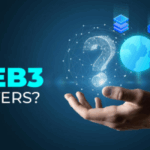In an era where data has become the new oil and digital platforms control much of our online experience, a new paradigm is emerging to challenge the status quo — Web3. Often wrapped in jargon and buzzwords, Web3 is much more than a tech trend. It represents a radical shift in the architecture of the …
Web3 Demystified: How Decentralization Is Changing the Digital World

In an era where data has become the new oil and digital platforms control much of our online experience, a new paradigm is emerging to challenge the status quo — Web3. Often wrapped in jargon and buzzwords, Web3 is much more than a tech trend. It represents a radical shift in the architecture of the internet, one that emphasizes decentralization, user ownership, and transparency.
But what exactly is Web3? How is it reshaping the digital world, and why should we care? Let’s dive into the essence of Web3 and explore how it’s unlocking a future where the internet works for users — not just the platforms.
🚀 From Web1 to Web3: A Quick Evolution
To understand Web3, it helps to look at how the web has evolved:
- Web1 (The Static Web): The early internet of the 1990s was read-only. Users could consume information but had little interaction. Think static websites and basic HTML pages.
- Web2 (The Social Web): Starting in the early 2000s, Web2 brought interactivity. Social media, e-commerce, content creation — users could now create, share, and engage. But in doing so, they handed enormous control to centralized platforms like Facebook, Google, and Amazon.
- Web3 (The Decentralized Web): Web3 seeks to take back control. It’s an internet powered by blockchains, peer-to-peer networks, and smart contracts, enabling users to own their data, participate in governance, and interact without intermediaries.
🧩 What Makes Web3 Different?
1. Decentralization at the Core
In Web3, no single entity owns or controls the network. Instead of centralized servers, information and value are distributed across nodes. This reduces risks like censorship, single points of failure, and monopolistic control.
Example: Instead of hosting files on AWS or Google Cloud, a Web3 platform might use IPFS (InterPlanetary File System), where files are stored across a decentralized network.
2. True Digital Ownership
Through blockchain wallets and non-fungible tokens (NFTs), users own their digital identities, assets, and data. There’s no need to rely on platforms to validate ownership — the blockchain does that.
Use case: In Web2, buying a digital skin in a game ties you to that specific platform. In Web3, you own the asset and can transfer it, sell it, or use it across platforms that support the same standards.
3. Programmable Trust with Smart Contracts
Smart contracts are self-executing programs that run on blockchains. They remove the need for middlemen, allowing transactions and agreements to be enforced transparently and autonomously.
Example: A decentralized lending protocol like Aave uses smart contracts to connect borrowers and lenders directly, eliminating banks or brokers.
4. User-Centric Governance
Web3 platforms often adopt Decentralized Autonomous Organizations (DAOs) — collectives that allow users to vote on changes, updates, or funding proposals. This participatory model stands in stark contrast to top-down decisions in Web2 companies.
🌐 Changing the Game: Web3 Use Cases in Action
Web3 isn’t a hypothetical future — it’s already in motion. Here are some examples of how decentralization is actively reshaping industries:
- Finance (DeFi): Decentralized finance platforms like Uniswap and Compound are offering banking services — trading, lending, earning — without banks.
- Art and Culture (NFTs): Artists are monetizing their work directly via NFTs, bypassing galleries and agents.
- Gaming (Play-to-Earn): Games like Axie Infinity have enabled users in developing countries to earn real income by participating in decentralized economies.
- Social Media (Decentralized Networks): Platforms like Lens Protocol and Farcaster aim to let users control their content, audience, and monetization pathways.
🔐 Privacy and Data Control
In Web2, users trade privacy for convenience. Companies collect vast amounts of data, often without clear consent or compensation. Web3 flips this dynamic:
- Users can control access to their data via cryptographic keys.
- Identity is self-sovereign, meaning you own your login, profile, and reputation, often through a wallet address.
- Protocols like Zero-Knowledge Proofs (ZKPs) are enabling authentication and verification without revealing sensitive data.
⚖️ Challenges Ahead: The Road Is Not Without Bumps
Despite its promise, Web3 faces real-world challenges:
- Scalability: Blockchains are still slower and more expensive than centralized systems. Solutions like Layer 2 networks (e.g., Optimism, Arbitrum) are working to fix this.
- Usability: Crypto wallets, gas fees, and private key management remain barriers for everyday users. Better UX is essential for mainstream adoption.
- Regulation: Governments are grappling with how to classify and regulate decentralized platforms and assets, raising uncertainty.
- Energy Use: While Ethereum’s move to Proof of Stake significantly reduced its energy footprint, some blockchains still face criticism for high energy consumption.
🔮 Web3 and the Future of the Internet
Web3 is more than just a tech evolution — it’s a socioeconomic shift. It challenges who gets to control platforms, who profits from data, and who governs digital spaces.
Imagine:
- An internet where creators get paid directly, with no need for platforms to take a cut.
- A world where communities fund and govern themselves through tokens and DAOs.
- A system where digital identity is portable, secure, and not owned by corporations.
While Web3 is still in its infancy, it represents a reimagination of the web, aligning technology with the ideals of transparency, equity, and decentralization.
📌 Final Thoughts: Why It Matters Now
We’re at an inflection point. The current web is powerful, but it’s flawed — riddled with data breaches, monopolies, and opaque algorithms. Web3 doesn’t promise perfection, but it offers an alternative — one where users are stakeholders, not just consumers.
As we move forward, the question isn’t whether Web3 will shape the digital future — it’s how fast, and who will build it.
Whether you’re a developer, investor, artist, or everyday user, Web3 invites you to participate, not just consume.
Welcome to the decentralized era.







